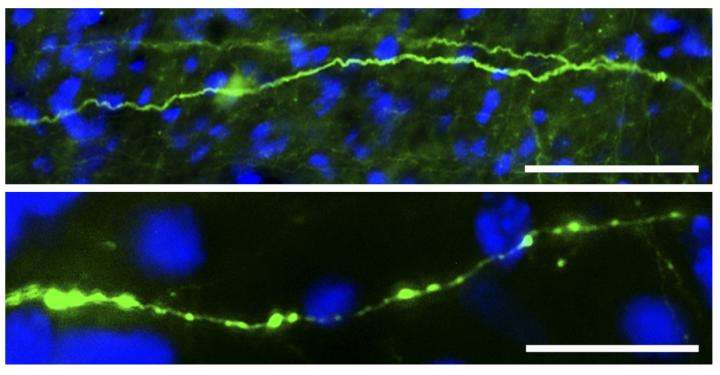How blows to the head cause numerous small swellings along the length of neuronal axons

Researchers from The Ohio State University have discovered how blows to the head cause numerous small swellings along the length of neuronal axons. The study, "Polarity of varicosity initiation in central neuron mechanosensation," which will be published June 12 in The Journal of Cell Biology, observes the swelling process in live cultured neurons and could lead to new ways of limiting the symptoms associated with concussive brain injuries.
Mild traumatic brain injuries, or concussions, cause a variety of temporary symptoms, including headache, nausea, and memory loss. But the effects of concussive impacts on neurons in the brain are poorly understood. One such effect is the development of "axonal varicosities," small, bead-like swellings that appear along the length of neuronal axons, which are the parts of neurons that transmit electrical and chemical signals to neighboring nerve cells. Similar swellings are seen in the degenerating axons of Alzheimer's and Parkinson's patients.
Chen Gu and colleagues at The Ohio State University discovered that they could induce the formation of axonal varicosities in hippocampal neurons grown in the lab by "puffing" them with bursts of liquid from a small pipette. The pressure exerted by these puffs was similar to the forces neurons might experience after a blow to the head.
The axonal varicosities formed rapidly, particularly in younger neurons where they swelled up within 5 seconds of being puffed. A surprise to the researchers was that the varicosities disappeared several minutes after puffing, indicating that they are not a sign of irreversible axon degeneration.
Gu and colleagues could also induce axonal varicosities by repeatedly puffing cultured neurons with shorter bursts of liquid, mimicking the effects of repetitive, subconcussive impacts. Accordingly, the team also saw axonal varicosities in the brains of mice subjected to repeated light blows to the head.
The researchers found that puffing activated a mechanosensitive channel protein called TRPV4, which is enriched in the membrane of neuronal axons and allows calcium ions to enter the cell. Inhibiting this channel blocked the formation of axonal varicosities.
After entering axons through activated TRPV4 channels, calcium ions appear to disrupt the microtubule cytoskeleton by inhibiting a microtubule-stabilizing protein called STOP. This interrupts the transport of cellular materials along axonal microtubules, causing these materials to accumulate at several points along the axon where they may give rise to varicosities.
Older neurons, which are more resistant to the effects of puffing, express lower levels of TRPV4 and higher levels of STOP. "It will be interesting to determine whether these factors make a mature brain more resistant to mild traumatic brain injury than a young brain," says Gu.
Puffing didn't induce varicosities along the lengths of dendrites, the parts of neurons that receive chemical signals from neighboring nerve cells. Instead, the researchers found that dendritic, but not axonal, varicosities could be induced by prolonged treatment with glutamate, an excitatory neurotransmitter that is released from damaged axons.
"Taken together, our findings provide novel mechanistic insights into the initial stage of a new type of neuronal plasticity in health and disease," says Gu, who points out that axonal varicosities have also been observed in healthy brains where neurons may respond to mechanical signals from their environment. "This process may therefore play a key role in neural development and central nervous system function in adults, as well as in chronic brain disorders and various acute brain injuries."
More information: Gu et al., 2017. J. Cell Biol.DOI: 10.1083/jcb.201606065


















